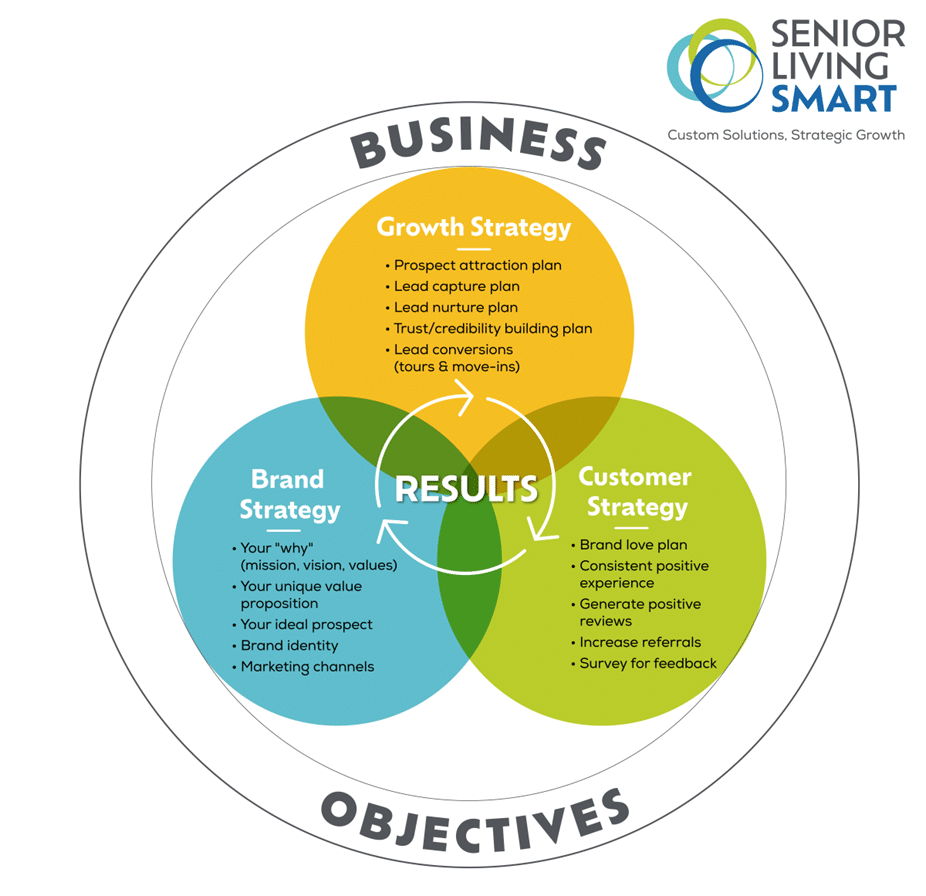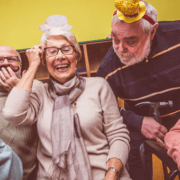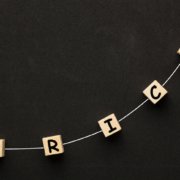Marketing Strategy for Senior Living: A SMARTER Approach
An effective marketing strategy for senior living begins with defining your business objectives and integrating them into your brand, growth, and resident (post-sale) strategies.
Below, we briefly explore each area, resulting in a blueprint you and your team can follow.
Strong business objectives build a strong foundation for your marketing strategy for senior living.
Every effective marketing strategy starts with well-defined business objectives. These objectives guide all subsequent decisions and ensure your efforts align with your community’s overarching goals.

For senior living, objectives might include . . .
- Breaking up with aggregators or reducing your reliance on them for lead generation
- Attracting the “younger senior” with less acuity/frailty
- Extending lengths of stay
- Shortening the sales cycle
When developing your business objectives, focus on specifics and concrete figures.
Using the above list as an example, here’s what those concrete figures might look like:
- Reduce dependence on aggregators by 30%
- Bring the average age of new residents down from 82 to 78
- Extend the length of stay in independent living from five years to seven years
- Shorten the sales cycle for assisted living from six months to four months
Keep these objectives in mind when developing your brand, growth, and resident strategies.
Weave a killer brand strategy into your overall marketing strategy.
The goal is to create and maintain a strong brand identity that resonates with prospects, residents, and referral partners and helps differentiate your community from the sea of sameness.
Key components of a brand strategy include:
- Your “why”: Clarify your community’s purpose and mission. What drives your team’s passion for serving seniors?
- Ideal Client (Resident) Profile (ICP): Think of your best residents. They are your ICP. Does your website speak to your ideal resident, or is it trying to be everything to everyone?
- Value proposition and unique selling proposition (USP). Your value proposition is how prospects benefit if they choose your community. (Think of it like this: What’s in it for them if they move in?) Your USP is that special something-something that makes your community different from your competitors.
- Brand identity: Develop consistent messaging and visuals to establish trust and recognition.
Develop a growth strategy focused on driving new opportunities.
A growth strategy focuses on attracting, capturing, nurturing, and converting leads. The goal is to create a seamless journey for potential residents from awareness to decision-making.
Here’s a breakdown of essential growth elements:
- Attraction: Use your website, social media, and other channels to increase targeted traffic and generate interest. Showcase testimonials, reviews, and affiliations to foster trust.
- Lead capture: Implement tools like landing pages, forms, and calls-to-action to capture visitor information.
- Lead nurture: Use marketing automation, personalized content, and other tactics to build relationships with leads over time.
- Lead conversion: Leverage marketing technology (martech) to streamline the sales process and track key performance indicators (KPIs), such as:
- Marketing-qualified lead (MQL) to sales-qualified lead (SQL))
- SQL to tour
- Tour to deposit or tour to move-in
- Prospect re-engagement: For leads that get stuck in the pipeline, use digital retargeting with paid ads, targeted workflows to advance MQLs/pre-tour leads, and targeted workflows to nudge post-tour leads that have stalled. You can also use a workflow to re-engage leads sitting in the “cold” and “lost but not disqualified” status in the CRM. (We have effective workflows for all of these scenarios.)
Don’t stop once you close a prospect.
Post-sale strategies are just as critical as pre-sale efforts. By prioritizing resident experience, you can boost retention and strengthen your reputation, leading to more organic growth.
In fact, senior living professional Jamison Gosselin conducted a survey that revealed personal referrals (like friends and family) had a ton of influence on those learning about specific retirement communities (this was cited by 52% of respondents). Building an intentional customer strategy that fosters brand ambassadors will lead to increased referrals (and these leads tend to have the highest conversion rate).
Key elements to keep in mind during the post-sale stage include:
- Onboarding plan: Moving is stressful. To make it easier for new residents to move in, provide valuable resources for downsizing, packing, choosing a mover, and planning for move-in day.
- Welcome program: The first 30 days can make or break a new resident. Develop a new resident welcome program that’s as special on day one as it is on day 30.
- Retention plan: Never stop delighting residents. Keeping residents happy will reduce turnover while creating new brand ambassadors.
- Referral program: Develop a referral program that makes it easy for happy residents and their families to refer others to your community.
Bring it all together in one comprehensive marketing strategy for senior living.
Do you need help putting all the pieces together and seamlessly executing various tactics? We can help. Get in touch to discuss your community’s marketing strategy.













Leave a Reply
Want to join the discussion?Feel free to contribute!